
Fly tying
Encyclopedia
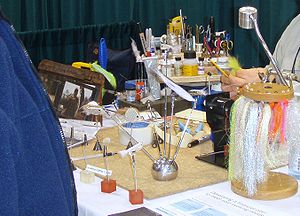
Artificial fly
An artificial fly or fly lure is a type of fishing lure, usually used in the sport of fly fishing . In general, artificial flies are the bait which fly fishers present to their target species of fish while fly fishing...
to be used by anglers
Angling
Angling is a method of fishing by means of an "angle" . The hook is usually attached to a fishing line and the line is often attached to a fishing rod. Fishing rods are usually fitted with a fishing reel that functions as a mechanism for storing, retrieving and paying out the line. The hook itself...
to catch fish
Fish
Fish are a paraphyletic group of organisms that consist of all gill-bearing aquatic vertebrate animals that lack limbs with digits. Included in this definition are the living hagfish, lampreys, and cartilaginous and bony fish, as well as various extinct related groups...
via means of fly fishing
Fly fishing
Fly fishing is an angling method in which an artificial 'fly' is used to catch fish. The fly is cast using a fly rod, reel, and specialized weighted line. Casting a nearly weightless fly or 'lure' requires casting techniques significantly different from other forms of casting...
. Probably the most concise description of fly tying is the one by Helen Shaw, a preeminent American professional fly tyer in Fly-Tying.
"Fly-tying is a simple process of binding various materials to a hook with thread.".Many fly-tyers consider fly tying an art, such as E. C. Gregg in introduction to How To Tie Flies.
"The object of this book will be throughout its entirety to teach in a practical manner the Art of Fly Tying in all its branches.”
At the other end is the apparent view of A. K. Best, a well known professional fly tyer and writer whose book, Production Fly Tying, suggests practical ways to streamline tying technique. Best emphasizes that fly tying is also a science rooted in careful observation of fish and their prey, and then designing and tying artificial flies to replicate that prey to catch fish. One of the first and foremost of these efforts was by Preston Jennings, in his classic: A Book of Trout Flies.
Fly tying requires some basic equipment, the appropriate materials for the fly pattern being tied and a fly pattern to follow or replicate. Fly tying equipment enables the fly tyer to efficiently and effectively assemble and secure the materials on the hook. Flying materials were originally limited to various fur
Fur
Fur is a synonym for hair, used more in reference to non-human animals, usually mammals; particularly those with extensives body hair coverage. The term is sometimes used to refer to the body hair of an animal as a complete coat, also known as the "pelage". Fur is also used to refer to animal...
s, feather
Feather
Feathers are one of the epidermal growths that form the distinctive outer covering, or plumage, on birds and some non-avian theropod dinosaurs. They are considered the most complex integumentary structures found in vertebrates, and indeed a premier example of a complex evolutionary novelty. They...
s, threads
Yarn
Yarn is a long continuous length of interlocked fibres, suitable for use in the production of textiles, sewing, crocheting, knitting, weaving, embroidery and ropemaking. Thread is a type of yarn intended for sewing by hand or machine. Modern manufactured sewing threads may be finished with wax or...
and hooks
Fish hook
A fish hook is a device for catching fish either by impaling them in the mouth or, more rarely, by snagging the body of the fish. Fish hooks have been employed for centuries by fishermen to catch fresh and saltwater fish. In 2005, the fish hook was chosen by Forbes as one of the top twenty tools...
. Today there many different types of natural and synthetic
Synthetic fiber
Synthetic fibers are the result of extensive research by scientists to improve on naturally occurring animal and plant fibers. In general, synthetic fibers are created by forcing, usually through extrusion, fiber forming materials through holes into the air, forming a thread...
materials used to tie flies. Fly patterns represent the “recipe” required to create the fly—what hook size(s) types to use, what materials are to be used, what colors, in what sequence and by what methods are they assembled on the hook. These are the elements of fly patterns. Of patterns, there are thousands.
Hand-tied flies on the commercial market retail from less than a dollar to several dollars each. Fly tying is a challenging and rewarding hobby
Hobby
A hobby is a regular activity or interest that is undertaken for pleasure, typically done during one's leisure time.- Etymology :A hobby horse is a wooden or wickerwork toy made to be ridden just like a real horse...
for some, a money-saving strategy
Strategy
Strategy, a word of military origin, refers to a plan of action designed to achieve a particular goal. In military usage strategy is distinct from tactics, which are concerned with the conduct of an engagement, while strategy is concerned with how different engagements are linked...
for some fly fishermen, and a profitable commercial enterprise for the professional tyer. The professional, commercial fly tyer may produce upwards 3000 dozen flies annually, whereas the amateur
Amateur
An amateur is generally considered a person attached to a particular pursuit, study, or science, without pay and often without formal training....
fly tyer may tie only a few flies each season for personal use.
Fly tying history
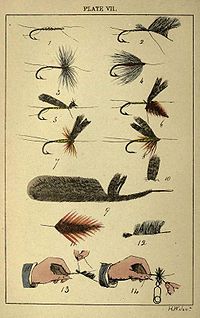
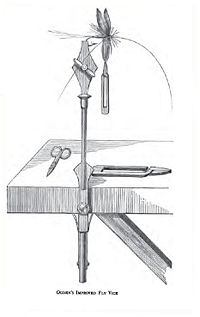

Your materials being now in a state of readiness, the hook must be first tied on with waxed silk to the finest end of the hair or gut left after cutting off the curled end, in this manner (Plate vii. No. 1) : Take the bend of the hook between your left finger and thumb, the shank projecting; place an end of the waxed silk, which should be about six inches in length, and the end of the gut along the underside of the shank; pass the silk over until you have wrapped it down to the end of the shank, and two or three turns back for the head of the fly ; take the feather or hackle as prepared (Plate vii. No. 2), put the point of the feather from where it is turned back with the outside next the hook, and hold it there with your left finger and thumb until you pass the silk over it, just where you left off, wrapping it twice or thrice on its downward rounds to the bend of the hook ; take your scissors and cut off the root of the feather, and the superfluous gut under the bend
of the hook, leaving it not quite so long as the body of the fly has to be made ; take the thick end of your feather in your tweezers or pliers and wrap it over three or four times close together, following the silk wrappings until it is all, or as much as you deem sufficient, twirled on; then take your silk and pass over the end once or twice; cut off the superfluous part of the feather and wrap up the shank with the silk, evenly and regularly, to form the body of the fly, and fasten off by a loop-knot or two; or,if you want a thick-bodied fly or one of flossed silk, turn down again and fasten off at the shoulder ; cut off the silk left, set the feather right with your needle and finger
and thumb, and the fly is made or dressed. This is the simplest method.
One of the earliest references to the use of a fly tying vise is in Ogden on Fly Tying (London, 1887). Other fly tying tools—scissors, hackle pliers, bodkins, etc. have remained remarkably similar for the last 120 years.
Imitation
Tying artificial flies has always been about imitatingImitation
Imitation is an advanced behavior whereby an individual observes and replicates another's. The word can be applied in many contexts, ranging from animal training to international politics.-Anthropology and social sciences:...
some form of fish prey with natural and/or synthetic materials bound to a hook. Significant literature exists, especially for trout flies, on the concepts of imitation. A Book of Trout Flies – Jennings (1935), Streamside Guide to Naturals & Their Imitations– Art Flick (1947), Matching the Hatch – Schweibert (1955), Selective Trout-Swisher and Richards (1971), Nymphs-Schweibert (1973), Caddisflies-LaFontaine (1989), Prey-Richards (1995) are but a few 20th century titles that deal extensively with imitating natural prey. However, from the human perspective, many fly patterns do not exactly imitate fish prey found in nature, yet they still are successful patterns. As such, a successful or killing fly pattern, therefore imitates something that the target species preys on. This has resulted in fly tiers and fishers devising additional terms to characterize those flies that obviously don’t imitate anything in particular, yet are successful at catching fish. These additional terms are inconsistently, but commonly associated with trout fly patterns because of the huge variety of patterns, both historical and contemporary. The term Attractor pattern has been applied to flies that resemble nothing in particular, but are successful in attracting strikes from fish (Trout Fishing, Brooks 1972). Dick Stewart in Flies for Trout (1993) characterizes these same patterns as General Purpose. Dave Hughes in Trout Flies-The Tier’s Reference (1999) describes the same flies as Searching flies and characterizes three levels of imitation: Impressionistic, Suggestive and Imitative.
Paul Schullery in American Fly Fishing – A History (1996) and The Rise (2006) explains however that although much has been written about the imitation theories of fly design, all successful fly patterns must imitate something to the fish, and even a perfect imitation attracts strikes from fish. The huge range of fly patterns documented today for all sorts of target species-trout
Trout
Trout is the name for a number of species of freshwater and saltwater fish belonging to the Salmoninae subfamily of the family Salmonidae. Salmon belong to the same family as trout. Most salmon species spend almost all their lives in salt water...
, salmon
Salmon
Salmon is the common name for several species of fish in the family Salmonidae. Several other fish in the same family are called trout; the difference is often said to be that salmon migrate and trout are resident, but this distinction does not strictly hold true...
, bass
Bass (fish)
Bass is a name shared by many different species of popular gamefish. The term encompasses both freshwater and marine species. All belong to the large order Perciformes, or perch-like fishes, and in fact the word bass comes from Middle English bars, meaning "perch."-Types of basses:*The temperate...
and panfish
Panfish
A panfish, also spelled pan-fish or pan fish, is an edible game fish that usually doesn't outgrow the size of a frying pan. The term is also commonly used by anglers to refer to any small catch that will fit in a pan, but is large enough to be legal. However its definition and usage varies with...
, pike
Esox
Esox is a genus of freshwater fish, the only living genus in the family Esocidae — the esocids which were endemic to North America, Europe and Eurasia during the Paleogene through present.The type species is E. lucius, the northern pike...
, saltwater, tropical exotics, etc. are not easily categorized as merely imitative, attractors, searching, impressionistic or something else.
Tools

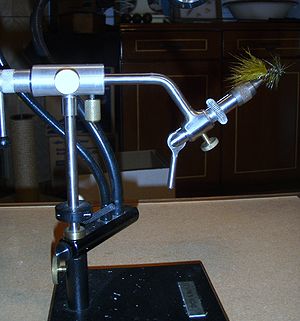
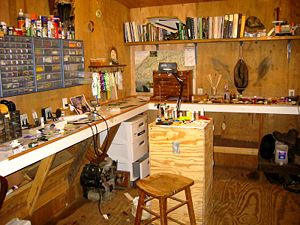
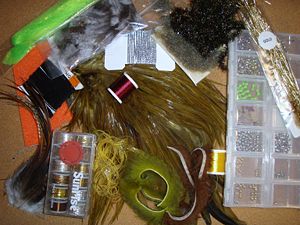
Bobbin
A bobbin is a spindle or cylinder, with or without flanges, on which wire, yarn, thread or film is wound. Bobbins are typically found in sewing machines, cameras, and within electronic equipment....
s, magnifying glass
Magnifying glass
A magnifying glass is a convex lens that is used to produce a magnified image of an object. The lens is usually mounted in a frame with a handle ....
for delicate work, hackle pliers, hackle gauges, lights, hair stackers, and scissors
Scissors
Scissors are hand-operated cutting instruments. They consist of a pair of metal blades pivoted so that the sharpened edges slide against each other when the handles opposite to the pivot are closed. Scissors are used for cutting various thin materials, such as paper, cardboard, metal foil, thin...
. Other optional tools are pliers, toothpick
Toothpick
A toothpick is a small stick of wood, plastic, bamboo, metal, bone or other substance used to remove detritus from the teeth, usually after a meal. A toothpick usually has one or two sharp ends to insert between teeth. They can also be used for picking up small appetizers or as a cocktail...
s, bodkins
Sewing needle
A sewing needle is a long slender tool with a pointed tip. The first needles were made of bone or wood; modern ones are manufactured from high carbon steel wire, nickel- or 18K gold plated for corrosion resistance. The highest quality embroidery needles are plated with two-thirds platinum and...
, dubbing twisters, blenders, floss bobbin
Bobbin
A bobbin is a spindle or cylinder, with or without flanges, on which wire, yarn, thread or film is wound. Bobbins are typically found in sewing machines, cameras, and within electronic equipment....
s, whip finishers, wing burners, and bobbin threaders.
Materials
Fly tying material can be anything that is used to construct a fly on a hook. Traditional materials were threads, , yarns, furs, feathers, hair, tinselTinsel
Tinsel is sparkling decorative material that mimics the effect of ice or icicles. When in long narrow strips, it emulates icicles. It was originally a metallic garland for Christmas decoration. The modern production of tinsel typically involves plastic, and is used particularly to decorate...
s, cork
Cork (material)
Cork is an impermeable, buoyant material, a prime-subset of bark tissue that is harvested for commercial use primarily from Quercus suber , which is endemic to southwest Europe and northwest Africa...
, balsa
Balsa
Ochroma pyramidale, commonly known as the balsa tree , is a species of flowering plant in the mallow family, Malvaceae. It is a large, fast-growing tree that can grow up to tall. It is the source of balsa wood, a very lightweight material with many uses...
and wire. Today's materials not only include all sorts of natural and dyed furs, hair and feathers but a wide array of synthetic materials. Rabbit
Rabbit
Rabbits are small mammals in the family Leporidae of the order Lagomorpha, found in several parts of the world...
, mink
Mink
There are two living species referred to as "mink": the European Mink and the American Mink. The extinct Sea Mink is related to the American Mink, but was much larger. All three species are dark-colored, semi-aquatic, carnivorous mammals of the family Mustelidae, which also includes the weasels and...
, muskrat
Muskrat
The muskrat , the only species in genus Ondatra, is a medium-sized semi-aquatic rodent native to North America, and introduced in parts of Europe, Asia, and South America. The muskrat is found in wetlands and is a very successful animal over a wide range of climates and habitats...
, fox
Fox
Fox is a common name for many species of omnivorous mammals belonging to the Canidae family. Foxes are small to medium-sized canids , characterized by possessing a long narrow snout, and a bushy tail .Members of about 37 species are referred to as foxes, of which only 12 species actually belong to...
, bear
Bear
Bears are mammals of the family Ursidae. Bears are classified as caniforms, or doglike carnivorans, with the pinnipeds being their closest living relatives. Although there are only eight living species of bear, they are widespread, appearing in a wide variety of habitats throughout the Northern...
, squirrel
Squirrel
Squirrels belong to a large family of small or medium-sized rodents called the Sciuridae. The family includes tree squirrels, ground squirrels, chipmunks, marmots , flying squirrels, and prairie dogs. Squirrels are indigenous to the Americas, Eurasia, and Africa and have been introduced to Australia...
and other furs, deer
Deer
Deer are the ruminant mammals forming the family Cervidae. Species in the Cervidae family include white-tailed deer, elk, moose, red deer, reindeer, fallow deer, roe deer and chital. Male deer of all species and female reindeer grow and shed new antlers each year...
, elk
Elk
The Elk is the large deer, also called Cervus canadensis or wapiti, of North America and eastern Asia.Elk may also refer to:Other antlered mammals:...
, moose
Moose
The moose or Eurasian elk is the largest extant species in the deer family. Moose are distinguished by the palmate antlers of the males; other members of the family have antlers with a dendritic configuration...
hair and chicken
Chicken
The chicken is a domesticated fowl, a subspecies of the Red Junglefowl. As one of the most common and widespread domestic animals, and with a population of more than 24 billion in 2003, there are more chickens in the world than any other species of bird...
, pheasant
Pheasant
Pheasants refer to some members of the Phasianinae subfamily of Phasianidae in the order Galliformes.Pheasants are characterised by strong sexual dimorphism, males being highly ornate with bright colours and adornments such as wattles and long tails. Males are usually larger than females and have...
, turkey
Turkey
Turkey , known officially as the Republic of Turkey , is a Eurasian country located in Western Asia and in East Thrace in Southeastern Europe...
, duck
Duck
Duck is the common name for a large number of species in the Anatidae family of birds, which also includes swans and geese. The ducks are divided among several subfamilies in the Anatidae family; they do not represent a monophyletic group but a form taxon, since swans and geese are not considered...
, goose
Goose
The word goose is the English name for a group of waterfowl, belonging to the family Anatidae. This family also includes swans, most of which are larger than true geese, and ducks, which are smaller....
and partridge
Partridge
Partridges are birds in the pheasant family, Phasianidae. They are a non-migratory Old World group.These are medium-sized birds, intermediate between the larger pheasants and the smaller quails. Partridges are native to Europe, Asia, Africa, and the Middle East...
feathers were and still commonly incorporated into artificial flies. Neck and saddle hackle from chickens, so critical to many artificial fly patterns is being especially bred for fly tying to achieve superior performance and color. Synthetics have allowed fly tyers to replicate rare and sometimes illegal and endangered furs and feathers and well as create completely new types of flies. Synthetics such as rubber
Rubber
Natural rubber, also called India rubber or caoutchouc, is an elastomer that was originally derived from latex, a milky colloid produced by some plants. The plants would be ‘tapped’, that is, an incision made into the bark of the tree and the sticky, milk colored latex sap collected and refined...
legs, plastic
Plastic
A plastic material is any of a wide range of synthetic or semi-synthetic organic solids used in the manufacture of industrial products. Plastics are typically polymers of high molecular mass, and may contain other substances to improve performance and/or reduce production costs...
wings and transparent plastic cords, chenilles, and all sorts and colors of flashy materials that can be incorporated into wings and bodies of today's artificial fly are available to the 21st Century fly tyer. Whereas lead
Lead
Lead is a main-group element in the carbon group with the symbol Pb and atomic number 82. Lead is a soft, malleable poor metal. It is also counted as one of the heavy metals. Metallic lead has a bluish-white color after being freshly cut, but it soon tarnishes to a dull grayish color when exposed...
wire was the traditional method of weighting flies, today's weighting materials include glass
Glass
Glass is an amorphous solid material. Glasses are typically brittle and optically transparent.The most familiar type of glass, used for centuries in windows and drinking vessels, is soda-lime glass, composed of about 75% silica plus Na2O, CaO, and several minor additives...
, brass
Brass
Brass is an alloy of copper and zinc; the proportions of zinc and copper can be varied to create a range of brasses with varying properties.In comparison, bronze is principally an alloy of copper and tin...
and tungsten
Tungsten
Tungsten , also known as wolfram , is a chemical element with the chemical symbol W and atomic number 74.A hard, rare metal under standard conditions when uncombined, tungsten is found naturally on Earth only in chemical compounds. It was identified as a new element in 1781, and first isolated as...
beads and cones as well as lead materials. Silicone
Silicone
Silicones are inert, synthetic compounds with a variety of forms and uses. Typically heat-resistant and rubber-like, they are used in sealants, adhesives, lubricants, medical applications , cookware, and insulation....
, epoxy
Epoxy
Epoxy, also known as polyepoxide, is a thermosetting polymer formed from reaction of an epoxide "resin" with polyamine "hardener". Epoxy has a wide range of applications, including fiber-reinforced plastic materials and general purpose adhesives....
, kevlar
Kevlar
Kevlar is the registered trademark for a para-aramid synthetic fiber, related to other aramids such as Nomex and Technora. Developed at DuPont in 1965, this high strength material was first commercially used in the early 1970s as a replacement for steel in racing tires...
thread and other modern materials are being incorporated in artificial fly patterns regularly.,
Hooks
The hookFish hook
A fish hook is a device for catching fish either by impaling them in the mouth or, more rarely, by snagging the body of the fish. Fish hooks have been employed for centuries by fishermen to catch fresh and saltwater fish. In 2005, the fish hook was chosen by Forbes as one of the top twenty tools...
determines the basic size and shape of each fly and is generally an important part of any fly pattern description. Hooks come in a wide range of sizes, shapes, lengths, and weights, and the hook must be selected to complement the pattern being tied and the method by which it will be fished. Additionally, flies constructed for use in saltwater are typically tied on corrosion
Corrosion
Corrosion is the disintegration of an engineered material into its constituent atoms due to chemical reactions with its surroundings. In the most common use of the word, this means electrochemical oxidation of metals in reaction with an oxidant such as oxygen...
-resistant hooks.
The fly pattern
The fly pattern is the recipeRecipe
A recipe is a set of instructions that describe how to prepare or make something, especially a culinary dish.-Components:Modern culinary recipes normally consist of several components*The name of the dish...
for any particularly named fly. In older literature, especially prior to the 20th century, fly patterns were referred to as dressings. The pattern specifies the size range and type of hook to be used, the materials to use, to include type, color and size and in some cases specific tying instructions to achieve a particular effect or configuration. Fly patterns allow tyers to consistently reproduce any given pattern over time. A Light Cahill dry fly produced by one tyer will look remarkably similar to the same fly produced by a completely different tyer if the pattern is followed with reasonable accuracy with comparable materials. Patterns may also layout alternatives for different materials and variations of the fly.
Fly patterns are usually found in fly fishing and fly tying literature and periodicals to include on-line sources. Although fly patterns do provide some consistency, different writers may publish patterns that contain small to moderate differences across pattern descriptions for the same fly. In many cases, the greatest differences are in tying technique instead of form, color and materials. Fly patterns may or may not have an image or drawing of the finished fly to guide the fly tyer. Historically, fly patterns have been included in texts that discuss fishing a particular genre of fly, fly fishing technique or fly fishing for specific species or genre
Genre
Genre , Greek: genos, γένος) is the term for any category of literature or other forms of art or culture, e.g. music, and in general, any type of discourse, whether written or spoken, audial or visual, based on some set of stylistic criteria. Genres are formed by conventions that change over time...
of gamefish. There are however, texts that are pure fly pattern and tying references with little or no instruction on how to fish them.
Parts of an artificial fly
Salmon flies have historically been the most complex and gaudy of artificial flies. Texts describing fly tying techniques often use an image of a salmon fly to describe all the parts of an artificial fly. The parts described below are typical.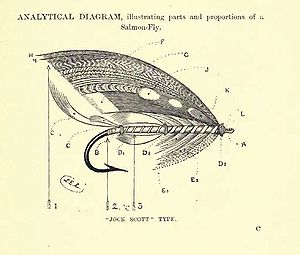 |
Key to Parts of Salmon Fly Image
|
Fly names
There is no convention or consistency in the naming of artificial flies. Long-standing, popular patterns have names that have persisted well over time. Fly designers, amateur or professional fly tyers however, are free to create any fly they choose and name it anyway they want to. Angling writers, the popular angling press, and professional fly tackle dealers have always introduced new patterns, with new names. The only naming convention is that there is no convention. Flies have been named to honor or celebrate fellow anglers: Royal Wulff, Jock Scott, Quill Gordon, Adams; named to describe their color and composition: Ginger Quill, Gold-ribbed Hare's Ear, Partridge and OrangePartridge and Orange
The Partridge and Orange is an Artificial fly commonly categorized as a wet fly or soft hackle and is fished under the water surface. The fly is a well known fly with its roots set firmly in English angling history. It is an impressionistic pattern fished successfully during caddis hatches and...
; named to reflect some regional origin: Bow River Bugger, Tellico nymph, San Juan worm; named to reflect the prey they represent: Golden stone, Blue-wing Olive, Pale Morning Dun, White swimming shrimp; named to reflect nothing in particular: Woolly Bugger
Woolly Bugger
The Woolly Bugger is an artificial fly commonly categorized as a wet fly or streamer and is fished under the water surface. It is a popular and widely used pattern for both freshwater and saltwater game fish and is generally listed as one of the top patterns to have in any fly box...
, Crazy Charlie, Club Sandwich and more often than not named to reflect the name of the designer: Copper John nymph (John Barr), Clouser Deep Minnow
Clouser Deep Minnow
The Clouser Deep Minnow is an Artificial fly commonly categorized as a streamer and is fished under the water surface. It is a popular and widely used pattern for both freshwater and saltwater game fish and is generally listed as one of the top patterns to have in any fly box, especially for bass...
(Bob Clouser), Brooks' Montana stone (Charles Brooks), Carey Special (Colonel Carey), Dahlberg Diver (Larry Dahlberg).
The following is an example of how flies get their names and those names evolve over time.
- The Coachman
Most famous of all trout flies is the Coachman, originated by Tom Bosworth, who drove Queen Victoria's coach
- The Royal Coachman
The Royal Coachman was first made by John Haily a professional fly dresser living in New York City. In writing of other matters, he enclosed this fly for us to see, saying "A gentleman wanted me to tie up some Coachman for him to take to the north woods and to make them extra strong, so I have tied them with a little band of silk in the middle to prevent the peacock bodies from fraying out. I have also added a tail of the barred feathers of the wood-duck, and I think it makes a very handsome fly." A few evenings later, a circle of us were together "disputing the fly in question", one of the party claiming that numbers were "quite as suitable to designate the flies as so many nonsensical names." The others did not agree with him, but he said: "What can you do? Here is a fly intended to be a Coachman; but it is not the true Coachman; it is quite unlike it and what can you call it?" Mr. L. C. Orvis, brother of Mr. Charles Orvis, who was present said: "Oh that is easy enough; call it the Royal Coachman it is so finely dressed!" And this name in time came to known and used by all who are familiar with the fly.
- The Royal Wulff
I will be forever indebted to DanDan BaileyDan Bailey was a fly-shop owner, innovative fly developer and staunch Western conservationist. Born on a farm near Russellville, Kentucky, Bailey is best known for the fly shop he established in Livingston, Montana in 1938...
[Dan Bailey] for his companionship and inspiration. Indebted, too, because it was Dan who insisted on giving my name to the Wulff Series and gave me stature I might never have had otherwise. We were fishing together on the Esopus in the spring of 1930 when I was trying out some new flies I'd designed in revolt to the then available Catskill patterns. The new flies had bucktail wings and tails for better floatation. I had planned to call one of them the Bucktail Coachman. It was Dan who insisted that I call them Wulffs and he started tying them under that name-Lee Wulff in the tribute in Mist on the River-Remembrances of Dan Bailey.
Typical fly patterns or dressing descriptions
The typical fly pattern will appear something like one of the illustrative patterns below for the Adams dry fly (without tying instructions) or the Clouser Deep MinnowClouser Deep Minnow
The Clouser Deep Minnow is an Artificial fly commonly categorized as a streamer and is fished under the water surface. It is a popular and widely used pattern for both freshwater and saltwater game fish and is generally listed as one of the top patterns to have in any fly box, especially for bass...
(with tying instructions). Based on the fly pattern, a knowledgeable fly tyer can reproduce the fly with the materials specified.
| Typical Fly Pattern Descriptions | |
|---|---|
| Fly | Pattern |
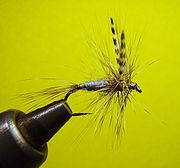 |
|
 |
Tying Instructions:
|
Fly pattern types
Historically, fly pattern types have evolved along with fly fishing itself and today there are generally recognized pattern types. However, none of them are absolute and there is much cross-over in patterns and pattern types. Typically the fly tyer will encounter patterns classified as: Dry Flies, Wet Flies, Soft Hackles, Emergers, Nymphs, Terrestrials, Bucktails and Streamers, Salmon (Atlantic) Flies, Steelhead and Salmon (Pacific) Flies, Bass Flies and Bugs, Poppers, Panfish Flies, Saltwater Flies, or Pike Flies. Even within these categories, there can be many sub-categories of imitative and non-imitative flies. For more detail on fly fishing with different types of patterns, see Fly fishingFly fishing
Fly fishing is an angling method in which an artificial 'fly' is used to catch fish. The fly is cast using a fly rod, reel, and specialized weighted line. Casting a nearly weightless fly or 'lure' requires casting techniques significantly different from other forms of casting...
and Artificial fly
Artificial fly
An artificial fly or fly lure is a type of fishing lure, usually used in the sport of fly fishing . In general, artificial flies are the bait which fly fishers present to their target species of fish while fly fishing...
.
A selection of historic and contemporary fly tying theory and pattern references
There are hundreds of fly fishing titles that contain fly tying instructions, fly patterns and information on fly tying tools and materials. Below is a selection of key American and British titles that span the history of fly tying theory from the mid-19th Century to the present day. Additional references on artificial flies and fly tying can be found in the Bibliography of fly fishing| Title | Comments |
|---|---|

|
|
Online Version (1855 Edition)
|
|
 |
|
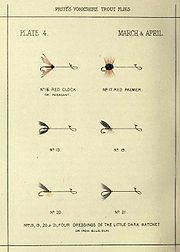
|
|
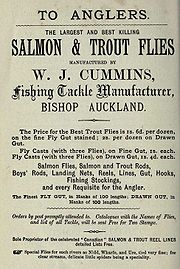 |
|
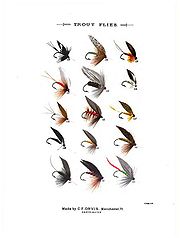
|
|
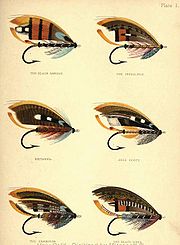
|
|
 |
|
 |
|
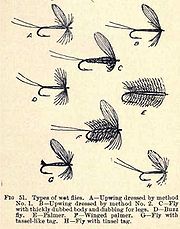 |
|
| Jennings was probably the first American Fly Fishing writer to tie the entomology Entomology Entomology is the scientific study of insects, a branch of arthropodology... of trout stream insects to the artificial flies and how to fish them in this 1935 seminal work. |
|
| Matching The Hatch was the first American book to cover fly imitiation from a transcontinental perspective and is widely read and reprinted. According to Paul Schullery, Matching The Hatch set the standard for fly entomology and tying studies for the late 20th Century. | |
| One of the most important angling books of the 20th Century A Modern Dry Fly Code, Marinaro revolutionized American trout fishing with his experiences on the Pennsylvania spring creeks in the 1940s and 50s. Dr. Andrew Herd wrote:
|
|
| Helen Shaw was considered the First Lady of Fly Tying by Arnold Gingrich and was considered one of the premier professional fly tyers of the mid-20th Century. Fly-tying—Materials, Tools and Techniques was a fly-tying bible in its time | |
| Describes the flies and nymphs significant in trout fishing, and explains the procedures for constructing imitations | |
| A comprehensive look at all aspects of Atlantic Salmon Atlantic salmon The Atlantic salmon is a species of fish in the family Salmonidae, which is found in the northern Atlantic Ocean and in rivers that flow into the north Atlantic and the north Pacific.... fishing and dressing Atlantic Salmon flies. Eight color plates of Flies. |
|
|
|
| Loaded with color photographs and descriptions of the natural materials such as fur, hair and feathers used in fly tying. | |
|
|
|
|
The Orvis Fly Tying Guide is a typical, comprehensive contemporary fly tying reference with excellent photographs on technique, equipment, patterns and tying instructions.
|
|
| A fly pattern reference for a specific genre of fly—the Clouser Deep Minnow Clouser Deep Minnow The Clouser Deep Minnow is an Artificial fly commonly categorized as a streamer and is fished under the water surface. It is a popular and widely used pattern for both freshwater and saltwater game fish and is generally listed as one of the top patterns to have in any fly box, especially for bass... --authored by the original designer of the fly.
|
|
| A typical contemporary fly pattern reference devoted to a specific genre of flies--Woolly Worms Woolly Worm (imitation) The Woolly Worm is an artificial fly commonly categorized as a wet fly or nymph and is fished under the water surface. It is a popular pattern for freshwater game fish and was a very popular fly in the 1950s – 1970s in the west. Charles Brooks in Nymph Fishing for Larger Trout recommends the... and Woolly Bugger Woolly Bugger The Woolly Bugger is an artificial fly commonly categorized as a wet fly or streamer and is fished under the water surface. It is a popular and widely used pattern for both freshwater and saltwater game fish and is generally listed as one of the top patterns to have in any fly box... s.
|
|
Fishing Flies: A World Encyclopedia of Every Type of Fly
|
See also
- Artificial flyArtificial flyAn artificial fly or fly lure is a type of fishing lure, usually used in the sport of fly fishing . In general, artificial flies are the bait which fly fishers present to their target species of fish while fly fishing...
for examples of different types of flies - Fly TyerFly TyerFly Tyer is an American magazine dedicated to the subject of fly tying, the art of tying materials to a hook for the purposes of fly fishing. Published four times a year, Fly Tyer is currently the largest fly-tying magazine in terms of circulation...
for a magazine devoted to fly tying

